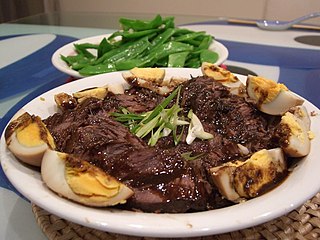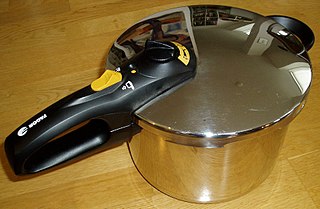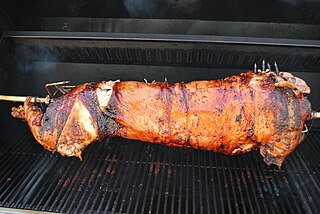
Cooking, also known as cookery or professionally as the culinary arts, is the art, science and craft of using heat to make food more palatable, digestible, nutritious, or safe. Cooking techniques and ingredients vary widely, from grilling food over an open fire, to using electric stoves, to baking in various types of ovens, reflecting local conditions. Cooking is an aspect of all human societies and a cultural universal.

Braising is a combination-cooking method that uses both wet and dry heats: typically, the food is first browned at a high temperature, then simmered in a covered pot in cooking liquid. It is similar to stewing, but braising is done with less liquid and usually used for larger cuts of meat. Braising of meat is often referred to as pot roasting, though some authors make a distinction between the two methods, based on whether additional liquid is added. Osso buco and coq au vin are well known braised meat dishes, and the technique can also be used to prepare fish, tempeh, tofu, or fruits and vegetables.

Sautéing or sauteing is a method of cooking that uses a relatively small amount of oil or fat in a shallow pan over relatively high heat. Various sauté methods exist.

Grilling is a form of cooking that involves heat applied to the surface of food, commonly from above, below or from the side. Grilling usually involves a significant amount of direct, radiant heat, and tends to be used for cooking meat and vegetables quickly. Food to be grilled is cooked on a grill, using a cast iron/frying pan, or a grill pan.

Pressure cooking is the process of cooking food with the use of high pressure steam and water or a water-based liquid, inside a sealed vessel called a pressure cooker; the high pressure limits boiling and creates higher temperatures not possible at lower pressures which allow food to be cooked much faster than at normal pressure.

Roasting is a cooking method that uses dry heat where hot air covers the food, cooking it evenly on all sides with temperatures of at least 150 °C (300 °F) from an open flame, oven, or other heat source. Roasting can enhance the flavor through caramelization and Maillard browning on the surface of the food. Roasting uses indirect, diffused heat, and is suitable for slower cooking of meat in a larger, whole piece. Meats and most root and bulb vegetables can be roasted. Any piece of meat, especially red meat, that has been cooked in this fashion is called a roast. Meats and vegetables prepared in this way are described as "roasted", e.g., roasted chicken or roasted squash.

Stir frying is a cooking technique in which ingredients are fried in a small amount of very hot oil while being stirred or tossed in a wok. The technique originated in China and in recent centuries has spread into other parts of Asia and the West. It is similar to sautéing in Western cooking technique.

In cooking, to coddle food is to heat it in water kept just below the boiling point. In the past, recipes called for coddling fruit, but in recent times the term is usually only applied to coddled eggs. Coddling differs from poaching in that the coddled ingredient is not placed directly in hot water, but instead in a small dish placed in a hot water bath. The process is either done in a regular pan or pot filled with water, either on the stovetop or placed in the oven, or through the use of a special device such as an "egg coddler". The oven technique is similar to the preparation of baked eggs, the difference being that the preparation of baked eggs does not have to employ a water bath.

Searing or pan searing is a technique used in grilling, baking, braising, roasting, sautéing, and the like, in which the surface of the food is cooked at high temperature until a browned crust forms. Similar techniques, such as browning and blackening, are typically used to sear all sides of a particular piece of meat, fish, poultry, etc. before finishing it in the oven. To obtain the desired brown or black crust, the meat surface must exceed 150 °C (300 °F), so searing requires the meat surface be free of water, which boils at around 100 °C (212 °F).

A slow cooker, also known as a crock-pot, is a countertop electrical cooking appliance used to simmer at a lower temperature than other cooking methods, such as baking, boiling, and frying. This facilitates unattended cooking for many hours of dishes that would otherwise be boiled: pot roast, soups, stews and other dishes.

Sous vide, also known as low-temperature, long-time (LTLT) cooking, is a method of cooking invented by the French chef Georges Pralus in 1974, in which food is placed in a plastic pouch or a glass jar and cooked in a water bath for longer than usual cooking times at a precisely regulated temperature.

The following outline is provided as an overview of and topical guide to the preparation of food:

Doneness is a gauge of how thoroughly cooked a cut of meat is based on its color, juiciness, and internal temperature. The gradations are most often used in reference to beef but are also applicable to other types of meat.
Low-temperature cooking is a cooking technique that uses temperatures in the range of about 60 to 90 °C for a prolonged time to cook food. Low-temperature cooking methods include sous vide cooking, slow cooking using a slow cooker, cooking in a normal oven which has a minimal setting of about 70 °C (158 °F), and using a combi steamer providing exact temperature control. The traditional cooking pit also cooks food at low temperature.

Deglazing is a cooking technique for removing and dissolving browned food residue from a pan to flavor sauces, soups, and gravies.

Seasoning is the process of coating the surface of cookware with fat which is heated in order to produce a corrosion resistant layer of polymerized fat. It is required for raw cast-iron cookware and carbon steel, which otherwise rust rapidly in use, but is also used for many other types of cookware. An advantage of seasoning is that it helps prevent food sticking.

A roasting pan or dripping pan is a piece of cookware used for roasting meat in an oven, either with or without vegetables or other ingredients. A roasting pan may be used with a rack that sits inside the pan and lets the meat sit above the fat and juice drippings.
In cooking several factors, including materials, techniques, and temperature, can influence the surface chemistry of the chemical reactions and interactions that create food. All of these factors depend on the chemical properties of the surfaces of the materials used. The material properties of cookware, such as hydrophobicity, surface roughness, and conductivity can impact the taste of a dish dramatically. The technique of food preparation alters food in fundamentally different ways, which produce unique textures and flavors. The temperature of food preparation must be considered when choosing the correct ingredients.

Extrusion in food processing consists of forcing soft mixed ingredients through an opening in a perforated plate or die designed to produce the required shape. The extruded food is then cut to a specific size by blades. The machine which forces the mix through the die is an extruder, and the mix is known as the extrudate. The extruder is typically a large, rotating screw tightly fitting within a stationary barrel, at the end of which is the die.


















